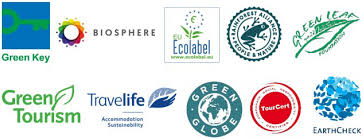Introduction to Environmental Certification
Environmental certification refers to a process through which businesses can obtain recognition for their sustainable practices and adherence to specific environmental standards. These certifications are established by various organizations and regulatory bodies, designed to ensure that companies operate in a manner that minimizes their ecological footprint. The criteria for earning such certifications often involve an assessment of a company’s operations, resource use, and waste management strategies. They encompass a wide range of areas including energy efficiency, waste reduction, and pollution control.
By attaining environmental certification, businesses not only demonstrate their commitment to sustainability, but they also enhance their credibility with consumers and stakeholders. Enhanced credibility can lead to increased customer loyalty, as modern consumers are increasingly conscientious about the environmental practices of the brands they choose to support. Additionally, many customers prefer to engage with companies that are transparent about their environmental impact and demonstrate responsibility through recognized certifications.
Environmental certifications such as ISO 14001, LEED, and Energy Star signify a company’s commitment to reducing environmental damage and mitigating climate change. Each of these certifications has specific criteria that must be met, involving both the implementation of policies and ongoing practices aimed at improving environmental performance. Subsequently, obtaining these certifications is not just about meeting regulatory requirements; it is also about fostering a culture of environmental responsibility and accountability, which can inspire other organizations to follow suit and adopt sustainable practices.
In today’s business landscape, where stakeholders are more invested in sustainability than ever, environmental certification serves as a vital tool. It facilitates the integration of sustainable practices into everyday business operations, enabling companies to contribute positively to the environment while also obtaining a competitive edge in their respective markets.
The Benefits of Environmental Certification for Businesses
Environmental certification serves as a significant asset to businesses striving for compliance and sustainability. One of the foremost advantages of obtaining such certification is the enhancement of a company’s reputation. A business that actively seeks to adhere to environmental standards demonstrates its commitment to responsible practices, which can resonate positively with consumers, stakeholders, and the community at large. This heightened reputation often leads to increased brand loyalty and an improved public image.
In addition to bolstering reputation, environmental certification provides a competitive advantage in the marketplace. As consumers become more environmentally conscious, they are more likely to favor companies that prioritize sustainability. This trend is particularly salient in industries where eco-friendliness is becoming a critical differentiator. Businesses that can showcase their commitment through certification can position themselves ahead of competitors who may not prioritize or communicate their sustainability efforts effectively.
Furthermore, obtaining environmental certification can lead to increased customer trust. When businesses are certified by a recognized entity, customers can have more confidence in the legitimacy of their sustainability claims. This trust can translate into higher customer retention rates and can attract new clients who are looking for responsible businesses to support. Trust is a vital element for success in today’s market, and certification helps establish a solid foundation for building lasting relationships with consumers.
Moreover, sustainability initiatives often lead to potential cost savings. Implementing energy-efficient practices, for instance, not only reduces a company’s carbon footprint but can also significantly lower utility costs. By focusing on sustainable practices, businesses can uncover efficiencies that contribute to their overall profitability.
Lastly, environmental certification can open new markets and opportunities. Many contracts and partnerships now require adherence to specific environmental standards, and having an appropriate certification can enable businesses to access these new avenues. Overall, businesses that embrace environmental certification position themselves for long-term success and sustainability in an evolving marketplace.
Compliance with Environmental Regulations
Environmental certification is a critical mechanism that enables businesses to align their operations with the requisite local, national, and international environmental laws. The evolving landscape of environmental regulations makes compliance not only a legal necessity but also a strategic imperative for sustainable business practices. By obtaining an environmental certification, a business demonstrates its commitment to adhering to the governing laws that safeguard our natural resources, ensuring it meets the standards set forth by regulatory authorities.
Failure to comply with environmental regulations can result in severe legal repercussions, including hefty fines, sanctions, or even the suspension of operations. Such penalties may significantly impact a company’s financial stability and brand reputation. With the global emphasis on sustainability, regulators are increasingly scrutinizing corporate practices associated with environmental performance. Consequently, businesses that proactively pursue environmental certification mitigate the risks of non-compliance. They position themselves as responsible entities that prioritize ecological health and social responsibility, enhancing their credibility in the market.
Moreover, environmental certification often entails regular audits and assessments, which helps businesses monitor their adherence to environmental standards. This ongoing evaluation process fosters a culture of accountability and continuous improvement within the organization. It illustrates to stakeholders, including customers, investors, and regulators, that the company is vigilant about its environmental impact and is actively working to reduce its carbon footprint.
Besides legal compliance, the investment in environmental certification often leads to operational efficiencies, cost savings, and access to new markets where sustainability is a decisive factor in procurement decisions. By prioritizing certification, businesses not only comply with regulations but also align themselves with the values of today’s consumers, who are increasingly inclined to support environmentally responsible companies.
The Role of Environmental Certification in Sustainability
Environmental certification plays a pivotal role in fostering sustainability within the business landscape. By adhering to established standards, businesses are not only demonstrating compliance with regulatory frameworks but also committing to improving their operational impact on the environment. The three pillars of sustainability—economic, social, and environmental—serve as a guiding framework for organizations seeking to achieve a balanced and responsible approach. Environmental certifications, such as ISO 14001 or LEED, can aid in addressing each of these pillars effectively.
From an economic perspective, adopting environmentally certified practices often leads to significant cost savings. For instance, through the implementation of energy-efficient systems and waste reduction strategies, businesses can decrease their operational costs while simultaneously minimizing their carbon footprint. Furthermore, these initiatives can enhance the brand’s reputation, ultimately attracting customers who are increasingly valuing sustainability in their purchasing decisions. The result is not only an improved bottom line but a competitive advantage in the marketplace as consumers gravitate towards environmentally responsible brands.
Social aspects of sustainability are equally addressed by environmental certification. Businesses that commit to sustainable practices often find themselves enhancing relationships with stakeholders, employees, and the local community. By prioritizing ethical sourcing and promoting fair labor practices, these organizations cultivate a positive work environment and foster community trust, both of which are essential for long-term success. Additionally, by engaging in community initiatives that focus on environmental conservation, certified companies can demonstrate their commitment to societal well-being.
Lastly, focusing on the environment ensures compliance with legal requirements and mitigates risks associated with ecological degradation. Through certifications, businesses can implement systematic approaches to identify, manage, and reduce their environmental footprint effectively. In doing so, they contribute meaningfully to the sustainability conversation, advocating for a healthier planet while securing their place within the broader economic and social fabric. This multifaceted impact illustrates how environmental certification is integral to achieving an overarching sustainable development strategy.
Types of Environmental Certifications
Environmental certifications serve as a significant means for businesses to demonstrate their commitment to sustainable practices and compliance with environmental regulations. Several certifications are widely recognized across various industries, each with its specific requirements and focus areas.
One of the most prominent certifications is ISO 14001, which provides a framework for organizations to develop an effective Environmental Management System (EMS). This certification emphasizes continuous improvement in environmental performance, encouraging businesses to consider the impact of their operations on the environment and resource utilization.
LEED (Leadership in Energy and Environmental Design) is another well-known certification, particularly within the construction and design sectors. LEED assesses the sustainability of buildings by evaluating factors such as energy efficiency, water savings, and sustainable site development. This certification is vital for organizations aiming to enhance their corporate responsibility and contribute to greener communities.
The Energy Star program focuses specifically on energy efficiency. Businesses engaged in manufacturing, commercial buildings, and residential properties can obtain this certification by demonstrating that their products or practices consume less energy than standard counterparts. Energy Star not only aids companies in reducing operational costs but also helps in lowering greenhouse gas emissions.
Additionally, there are other certifications like Eco-Management and Audit Scheme (EMAS) and Forest Stewardship Council (FSC) that cater to specific sectors. EMAS is an EU initiative that encourages organizations to assess and continuously improve their environmental performance, while FSC certification ensures that products come from responsibly managed forests that provide environmental, social, and economic benefits.
By understanding these various certifications, businesses can identify which aligns best with their operational goals and industry-specific requirements, paving the way for enhanced sustainability and compliance.
Challenges in Obtaining Environmental Certification
As businesses strive to align with sustainable practices and obtain environmental certification, they often encounter several significant challenges. One primary issue is the allocation of resources. Pursuing certification typically demands considerable investment in both time and personnel. Companies may need to designate staff members who are entirely focused on the certification process, which can divert attention from other critical operations. This resource allocation can lead to operational disruptions, particularly for smaller organizations that may not have the administrative bandwidth to manage additional responsibilities.
Another major impediment is the cost implications associated with obtaining environmental certification. Depending on the specific certification sought and the industry context, the expenses can be substantial. These costs may arise from hiring consultants to guide the certification process, investing in necessary equipment or technology, and implementing new procedures to meet certification standards. While the long-term benefits of certification, such as increased customer loyalty and market competitiveness, can be significant, the initial financial burden can be daunting for various businesses.
In addition to resource and cost challenges, knowledge gaps often hinder organizations in their pursuit of certification. Many businesses may not have a clear understanding of the specific requirements needed to achieve certification. This lack of knowledge can lead to inefficiencies, misunderstandings, and potential non-compliance with regulations. Organizations can overcome this obstacle by seeking educational resources, attending workshops, or collaborating with experts who can guide them through the intricate certification process.
The complexity of the certification process itself constitutes another challenge. Each certification body may have differing standards and procedures that can be difficult to navigate, especially for organizations new to sustainable practices. Therefore, businesses must familiarize themselves with these varied requirements and develop clear strategies for compliance. By addressing these hurdles through careful planning, adequate resource allocation, and enhancing knowledge, organizations can increase their likelihood of successfully obtaining environmental certification.
Case Studies: Successful Implementation of Environmental Certifications
Numerous businesses across various sectors have successfully navigated the process of obtaining environmental certifications, demonstrating that sustainability-oriented practices can coexist with profitability. One notable example is the multinational corporation Unilever, which has embraced the ISO 14001 certification to enhance its environmental management systems. Faced with challenges such as supply chain transparency and waste reduction, Unilever effectively implemented strategies that included establishing clear environmental objectives and engaging stakeholders at all levels. The rigorous guidelines provided by the certification helped them not only to streamline their processes but also to boost their brand reputation among environmentally conscious consumers.
Similarly, the automotive industry has seen significant advancements through environmental certifications. Toyota, a frontrunner in hybrid technology, achieved the Environmental Management System (EMS) certification, which guided the company in minimizing its environmental footprint. Initially, the company encountered difficulties related to energy consumption and emissions management. However, with commitment to continuous improvement and employee training, Toyota succeeded in reducing waste production by adopting lean manufacturing principles. This achievement not only resulted in substantial cost savings but also bolstered the company’s market position as a leader in sustainability.
In the food industry, the certification by Rainforest Alliance has encouraged companies like Ben & Jerry’s to adopt sustainable sourcing practices. The challenges associated with ethical sourcing and pesticide use were addressed by collaborating with farmers to achieve compliance with environmental standards. By integrating these practices, Ben & Jerry’s enhanced its product line, appealing to consumers who prioritize environmentally friendly products. The company has reported increased sales, demonstrating that sustainable business practices do translate into tangible benefits.
These case studies highlight the varying paths businesses can take towards achieving environmental certifications. The journey may be fraught with challenges, but the long-term benefits, such as enhanced operational efficiency, improved brand loyalty, and compliance with regulatory frameworks, make the effort worthwhile.
Future Trends in Environmental Certification
The landscape of environmental certification is rapidly evolving, influenced by technological innovations, shifting consumer expectations, and growing regulatory pressures. As businesses increasingly recognize the importance of sustainable practices, environmental certifications are becoming essential tools for demonstrating compliance and commitment to sustainability. One of the most notable trends is the integration of technology into the certification process. Advanced analytics, artificial intelligence, and blockchain technology are streamlining verification procedures, enhancing transparency, and enabling real-time data sharing. This technological shift not only reduces the burden of certification on businesses but also fosters greater trust among consumers who seek verified information about the environmental impact of products and services.
Furthermore, evolving consumer expectations are driving companies to adopt more rigorous sustainability measures. Today’s consumers are increasingly informed and concerned about the environmental footprint of their purchases. As a result, businesses are compelled to obtain credible certifications that resonate with this demographic. Eco-labels and sustainability certifications are no longer just optional; they are becoming a prerequisite for market participation. Companies that proactively seek environmental certification are likely to gain a competitive edge by appealing to this conscientious consumer base.
Additionally, regulatory pressures are intensifying, prompting businesses to adopt environmental certifications as a proactive compliance strategy. Governments worldwide are implementing stricter environmental regulations, creating a need for businesses to stay ahead of compliance requirements through recognized certifications. Such certifications not only help in adhering to regulations but also in avoiding costly penalties associated with non-compliance. This trend suggests that the future of environmental certification will be characterized by a more rigorous framework, aligning corporate practices with global sustainability goals. As environmental issues become increasingly urgent, the demand for credible certification will undoubtedly grow, shaping the future business landscape significantly.
Conclusion: The Path Forward for Businesses
As businesses navigate an increasingly complex regulatory landscape and face growing scrutiny from consumers regarding environmental practices, the importance of environmental certification cannot be overstated. Obtaining certification not only ensures compliance with local and international regulations but also positions companies as responsible corporate citizens. This commitment to sustainability fosters trust among stakeholders, including customers, suppliers, and investors, who are becoming more discerning about environmental issues.
Furthermore, environmental certification represents a strategic initiative that can differentiate a business in a competitive market. Companies that proactively embrace sustainability often witness enhanced brand loyalty and improved reputation. By integrating certified practices into their operations, businesses are not merely responding to external pressures; they are also setting themselves apart as leaders in environmental performance. In turn, these actions can lead to cost savings through efficiencies, waste reduction, and innovation.
Moreover, the journey toward environmental certification allows businesses to assess and improve their current practices. Organizations are encouraged to engage in a continuous improvement cycle, embracing best practices that minimize their ecological footprint. This commitment not only prompts positive environmental impacts but also aligns with the values of a growing demographic of eco-conscious consumers. Importantly, it prepares businesses to adapt to future regulations and market demands, thus ensuring long-term viability in a shifting economic climate.
In light of these factors, it is essential for businesses to recognize environmental certification as more than a regulatory obligation. It should be perceived as a vital component of a successful strategy aimed at ensuring sustainability and fostering resilience in today’s business environment. By prioritizing environmental responsibility, companies can contribute positively to the planet while securing their future in an increasingly conscious marketplace.
How useful was this post?
Click on a star to rate it!
Average rating 0 / 5. Vote count: 0
No votes so far! Be the first to rate this post.

















